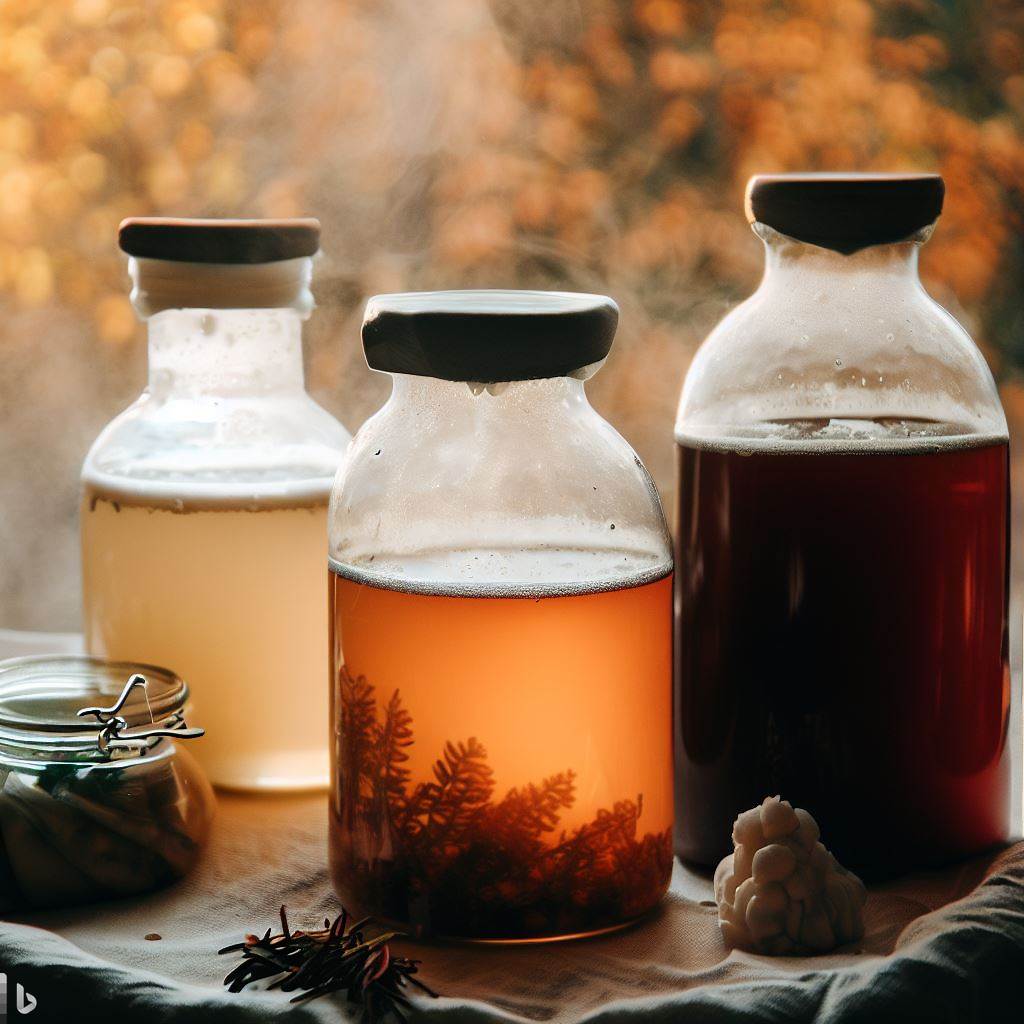As a passionate kombucha brewer, you know that the art of brewing this fizzy, fermented tea is a delicate dance between the SCOBY (Symbiotic Culture of Bacteria and Yeast), tea, sugar, and temperature. But did you know that the changing seasons can significantly impact your brew? In this blog, we’ll explore how to adapt your kombucha brewing strategy for each of the four seasons, ensuring a perfect batch every time. Now lets discuss Brewing Kombucha in Different Seasons; Let’s dive in!
Seasonal Strategies for Kombucha Brewing: A Year-Round Guide

1. Brewing Kombucha in Spring
As the flowers bloom and the temperatures rise, spring brings a renewed energy to the world of kombucha brewing. Here are some tips for brewing kombucha in the spring season:
The importance of temperature
During spring, the temperature tends to fluctuate. It’s crucial to find a consistent spot for your brewing vessels to maintain the ideal temperature for fermentation. Avoid placing your kombucha near direct sunlight or drafts.
Choosing the right tea
In spring, lighter and floral teas work well with kombucha. Consider using green tea, white tea, or a blend with floral notes to complement the season. Experiment with different tea combinations to find your favorite flavors.
Finding the perfect brewing spot
Spring is a time when you can take advantage of the pleasant weather and consider brewing kombucha outdoors. Just make sure to protect your brew from direct sunlight and outdoor contaminants. A covered porch or a shaded area in the garden can be an excellent spot.
Controlling fermentation time
Warmer temperatures in spring can speed up the fermentation process. Keep a close eye on your kombucha and adjust the brewing time accordingly. Remember, shorter fermentation can result in a milder taste, while longer fermentation leads to a tangier and more acidic brew.
2. Brewing Kombucha in Summer
With the scorching heat of summer, brewing kombucha requires special attention to prevent unwanted issues. Here’s how to keep your kombucha brewing journey cool during the summer months:
Dealing with higher temperatures
Summer heat can accelerate the fermentation process, leading to over-fermented and overly tangy kombucha. To avoid this, find a cool and consistent spot with a temperature range of 75-85°F (24-29°C) for optimal fermentation. Consider using a temperature-controlled environment like a fermentation chamber if necessary.
Adjusting brewing time
Due to the increased fermentation speed in summer, you may need to shorten your brewing time. Monitor the taste of your kombucha by conducting regular taste tests. Remember, it’s better to have a slightly milder brew than an overly acidic one.
Managing fruit flies
Warm weather attracts fruit flies, which can be a nuisance during the brewing process. To keep them at bay, cover your brewing vessel with a tightly woven cloth or use a fine mesh screen. Additionally, ensure your brewing area is clean and free from any fruit or sugar residue.
Flavor combinations for refreshing summer brews
Summer is the perfect time to experiment with vibrant and refreshing flavors. Add fresh fruits like berries, citrus, or tropical fruits to infuse your kombucha with a burst of summer goodness. You can also incorporate herbs like mint, basil, or lemongrass for a unique twist.
3. Brewing Kombucha in Autumn
As the leaves change color and the weather cools down, autumn offers an opportunity to create kombucha with cozy and seasonal flavors. Here’s how to embrace the spirit of fall in your brewing process:
Harvest-inspired flavors
Autumn is synonymous with pumpkin spice, apple pie, and other comforting flavors. Infuse your kombucha with cinnamon, nutmeg, cloves, or ginger to create a warm and aromatic brew. You can also experiment with roasted apples, pears, or cranberries for a delightful autumnal twist.
Using seasonal fruits and spices
Take advantage of the bountiful harvest and incorporate seasonal fruits and spices into your kombucha recipes. Think of apples, pomegranates, figs, or even roasted chestnuts. These ingredients not only add flavor but also reflect the essence of the season.
Managing humidity levels
Fall can bring higher humidity, which can affect the fermentation process. Ensure your brewing vessels are properly sealed to prevent excess moisture from entering. Consider using a dehumidifier in your brewing area if needed.
Tips for preserving kombucha during fall
As the temperatures drop, kombucha tends to ferment more slowly. To maintain the desired taste, store your kombucha in a warmer area of your house or use a heating pad or belt to provide a consistent temperature. Remember to adjust the brewing time accordingly to achieve the desired level of fermentation.
4. Brewing Kombucha in Winter
Winter presents unique challenges for brewing kombucha due to the colder temperatures. However, with the right strategies, you can continue enjoying your homemade kombucha during the cozy winter months:
Overcoming low temperatures
Low temperatures can significantly slow down the fermentation process, leading to longer brewing times. Find a warm spot for your kombucha, away from cold drafts or near heat sources like radiators or heating pads. Maintaining a temperature of 68-75°F (20-24°C) is ideal for winter brewing.
Extended fermentation times
In winter, be prepared for longer fermentation times. The colder environment slows down the activity of yeast and bacteria, resulting in a slower fermentation process. Regularly taste your kombucha to determine the optimal time for bottling.
Warm brewing methods
To combat the cold, you can employ warm brewing methods like continuous brewing or using a heating mat or belt. These methods help maintain a consistent temperature and ensure the fermentation process proceeds smoothly.
Cozy winter flavors and additions
Winter calls for comforting and cozy flavors in your kombucha. Consider adding spices like cardamom, star anise, or vanilla beans for a warm and inviting taste. You can also experiment with dried fruits such as cranberries, cherries, or raisins for added sweetness and depth.
5. Troubleshooting and Common Mistakes
Despite following the guidelines, kombucha brewing can sometimes go awry. Here are some common issues that arise and how to troubleshoot them:
Mold prevention and detection
Mold growth is one of the biggest concerns when brewing kombucha. To prevent mold, ensure proper hygiene by sanitizing all equipment and using filtered water. If you spot mold, discard the entire batch, sanitize your equipment thoroughly, and start afresh.
Controlling acidity and sweetness
Achieving the right balance of acidity and sweetness is key to a delicious kombucha. If your brew is too tart, reduce the fermentation time or use less starter liquid. For a sweeter brew, increase the fermentation time or add more sugar during the brewing process. Taste testing is crucial in finding your preferred balance.
Dealing with overly fizzy kombucha
Sometimes, kombucha can become excessively carbonated, resulting in explosive bottles or overly effervescent brews. To manage fizziness, ensure proper bottling techniques by leaving enough headspace and burping the bottles regularly to release excess gas. You can also refrigerate the bottles to slow down carbonation.
Adjusting the brewing process for desired taste
Kombucha is a versatile beverage, and personal preferences for taste can vary. If you find your brew too strong or too weak, experiment with adjusting the amount of tea, sugar, or fermentation time. Keep detailed notes of each batch to track the changes and refine your brewing process.
Final Thoughts
Finally, when brewing kombucha is a year-round journey, with each season offering its unique challenges and opportunities. By understanding and adapting to these seasonal changes, you can ensure a delicious, healthy brew all year round. Now, we’d love to hear from you. How do you adapt your kombucha brewing strategy for the changing seasons? Share your tips and tricks in the comments below! Happy Brewing y’all!
FAQs – Brewing Kombucha in Different Seasons
Q1: Can I brew kombucha in any season?
Yes, you can brew kombucha in any season. However, each season comes with its own considerations and challenges. By understanding the impact of temperature, humidity, and flavor profiles, you can optimize your brewing process for the specific season.
Q2: Can I use seasonal fruits in my kombucha?
Absolutely! Using seasonal fruits in your kombucha is a great way to add unique flavors and embrace the essence of each season. Experiment with different combinations and enjoy the burst of freshness and taste that seasonal fruits bring.
Q3: How do I know if my kombucha is fermenting properly?
You can determine if your kombucha is fermenting properly by observing the formation of a new SCOBY (Symbiotic Culture of Bacteria and Yeast) on the surface of the brew. Additionally, taste testing the kombucha at regular intervals allows you to monitor its flavor development and acidity levels.
Q4: Can I brew kombucha outdoors during summer?
Brewing kombucha outdoors during summer is possible, but it requires careful attention to temperature control and protection from direct sunlight and contaminants. Consider using a covered porch or a shaded area in the garden to maintain stable brewing conditions.
Q5: How long does it take to brew kombucha in winter?
Brewing kombucha in winter can take longer due to the colder temperatures. It may require an additional 1-2 weeks compared to brewing in warmer seasons. Regular taste testing will help you determine the optimal time for bottling based on your desired taste profile.
Thanks for reading on Brewing Kombucha in the Different Seasons. Read more GMK Articles:
- Tempature in Kombucha Brewing
- Best Booch Books
- Alcohol in Kombucha?
- YouTube Video on Brewing in the Seasons







